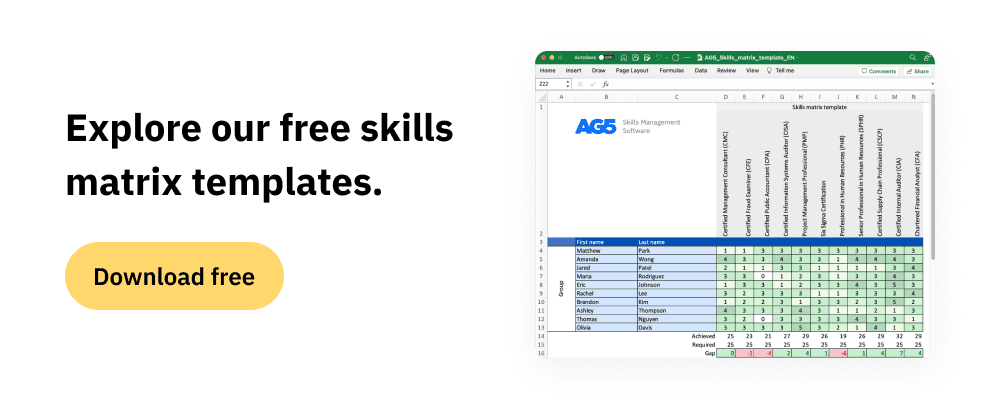Everything you need to know about skills matrices
Keeping track of your employees’ competences, skills, qualifications, and certifications is tricky business – especially if your organization is large, complex, or consists of multiple departments and teams. Of course, the right skills management software can go a long way toward helping you overcome such a challenge. Such software, however, is an all-encompassing solution, and you may need a quick fix....

Keeping track of your employees’ competences, skills, qualifications, and certifications is tricky business – especially if your organization is large, complex, or consists of multiple departments and teams.
Of course, the right skills management software can go a long way toward helping you overcome such a challenge. Such software, however, is an all-encompassing solution, and you may need a quick fix. That’s where skills matrices come in.
So exactly what is a skills matrix – and how do they work in practice? More importantly, how can you benefit from them? In this article, we’ll go through everything you need to know about skills matrices.
We’ll also demonstrate how skills matrices have changed over the years and provide you with a few useful tips about getting started using them in your organization.
What is a skills matrix?Copied
A skills matrix is a tool used by organizations to assess and track the skills, competencies, and proficiencies of their employees or team members. It is a visual representation – a matrix – that helps managers and team leaders identify the strengths and weaknesses within a team, department, or organization.
With a skills matrix you can:
- Identify and close skills gaps
- Develop targeted recruitment strategies
- Create upskilling and reskilling initiatives
- Plan for employee succession
How do skills matrices work? Skills and training matrices explainedCopied
A skills matrix template typically consists of a table, where each row represents an individual employee, and each column represents a specific skill or competency relevant to your organization’s goals.
To use a skills matrix, you fill the intersections of rows and columns with information indicating employees’ level of proficiency or competency in a particular skill. This is usually indicated by a number (for example, 0-5). You can then easily see the employees that are qualified to perform specific tasks, roles or duties.
A properly created skills matrix will provide you with full oversight of the skills your employees possess, as well as those that your organization needs to stay operational, compliant, and safe.
Below, you can see an example of a skills matrix that we created. You can download it free as Excel, Word and PDF file!

How to create a skills matrix: Step by stepCopied
Below, you’ll find our own four-step plan for creating and implementing a spreadsheet-based skills matrix into your skills management strategy. Once you’ve gotten used to using your spreadsheet skills matrix, you’ll be ready to take the next step in skills management: choosing and implementing the skills management software that best fits your organization.
Step #1 – Ask the right questions
Before you get started creating your skills matrix, it’s important to answer five crucial questions:
- What qualifications, skills, and certification do my employees need?
- What qualifications, skills, and certification do my employees already have?
- Is there a skills gap between what they need and what they already have?
- If so, how are we going to fill this gap? By training existing employees or recruiting new employees?
- How and where can we formally demonstrate the qualifications and skills we’ve acquired?
Step #2 – Create a skills overview
What skills, qualifications, or certifications do employees need to successfully and safely perform their roles and tasks? Answering this question and recording your answer will help you create a skills overview, which shows all the necessary skills, qualifications, and certifications your organization needs to stay safe and operational. An overview also shows you which employees are highly versatile (generalists) or have very specific skill sets (specialists).
Step #3 – Sort skills by department or team
Use your overview to sort skills by departments or teams within your organization. This means you can more easily ensure that every team or department has what it needs to work efficiently and effectively.
Step #4 – Populate your skills matrix template
Use the information you gathered in steps 1-3, and place it in a skills matrix template. Then determine and assign each employee’s proficiency level for each of the skills listed for the team, department, or organization.
Common mistakes when creating a skills matrixCopied
A skills matrix holds the potential to be an enormous benefit for your skills management strategy. However, there are a few things to look out for when creating one. Let’s take a look.
- Not updating the skills matrix regularly. Infrequent updates to your skills matrix can lead to inaccurate representations of employee capabilities.
- Overcomplicating a large skills matrix. Complex and convoluted skills matrices can overwhelm HR teams and employees – and greatly increase the chance of inaccurate information and other errors.
- Insufficiently linking skills to business goals. Failure to align employee skills with strategic business objectives can result in a workforce that lacks the capabilities needed to drive organizational success and innovation.
- Failing to integrate with other HR systems. A lack of integration between the skills matrix and other HR systems means you won’t have a holistic view of employee development needs across your organization.
- Relying on job titles instead of skills. Thinking in terms of job titles rather than actual skills can lead to misjudgments in talent placement. Just because someone has “manager” or “director” in their title does not necessarily mean they possess good leadership qualities!
Want to learn more about mistakes to avoid when creating a skills matrix? Check out our blog, “Pitfalls to avoid with skills matrices.”
Skills matrix in spreadsheets: Pros and consCopied
Overall, skills matrices bring organizations a wealth of benefits without much of a downside. However, spreadsheet-based skills matrices – such as those created in Excel – have a few disadvantages. Here, we’ll take a quick look at the advantages and disadvantages of spreadsheet-based skills matrices.
The advantagesCopied
Creating and maintaining skills matrices in a spreadsheet is advantageous to organizations’ skills management efforts on numerous fronts. It’s also important to note that many of these advantages also carry over to using skills matrices offered by skills management software.
- Low-cost solution. Spreadsheet software, such as Mircosoft Excel, is relatively inexpensive, and often already used by most organizations. This means getting a spreadsheet-based skills matrix up and running is essentially free.
- Easy integration. You can easily integrate spreadsheet files with other software tools and platforms, such as HR or project management systems.
- Easy data entry. You can input, edit, and update spreadsheets quickly – and whenever you want. It’s a piece of cake to add new skills or adjust a staff member’s proficiency level.
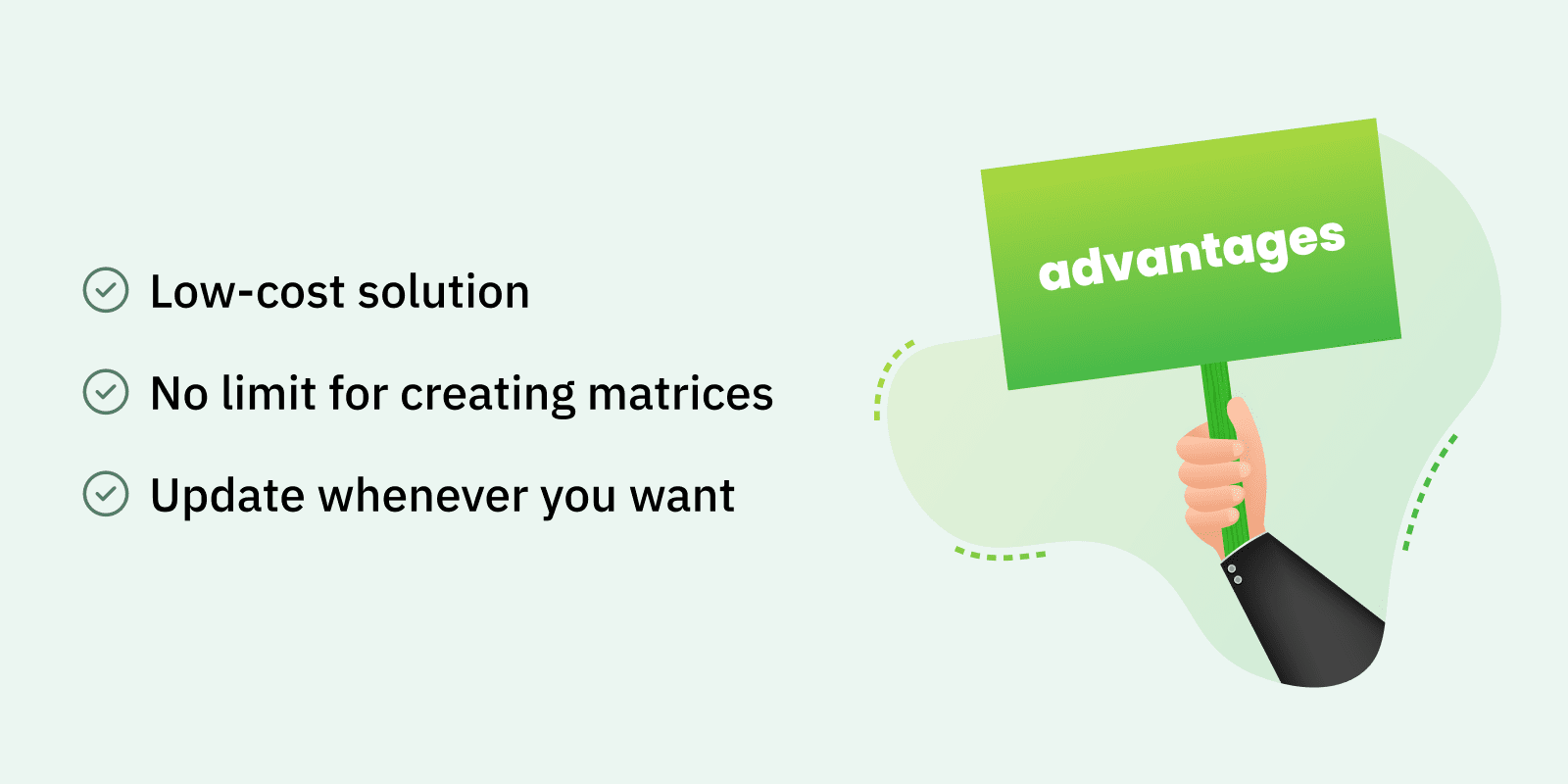
The disadvantagesCopied
Alas, it’s not always a bed of roses in spreadsheet land. There are plenty of pitfalls lurking that can undermine your attempts to properly manage your skills matrices. Luckily, these disadvantages are often mitigated by skills matrices in skills management software.
Let’s take a look at some of the most common disadvantages of spreadsheet-based skills matrices when compared to skills management software.
- Error-prone. Spreadsheets are also incredibly prone to errors. An inadvertent change to just one cell’s formula and the entire worksheet is ‘broken’ (human error).
- Version management. Collaboration on spreadsheets can lead to version control problems, especially when multiple team members are involved. Spreadsheets aren’t ideal for creating unified skills matrices that work for both individual teams and for your organization as a whole.
- Complicated and cumbersome. Creating a skills matrix in a spreadsheet means dealing with multiple tabs and formulas. The more complex the skills matrices become, the more you need an Excel guru with programming skills to manage them!
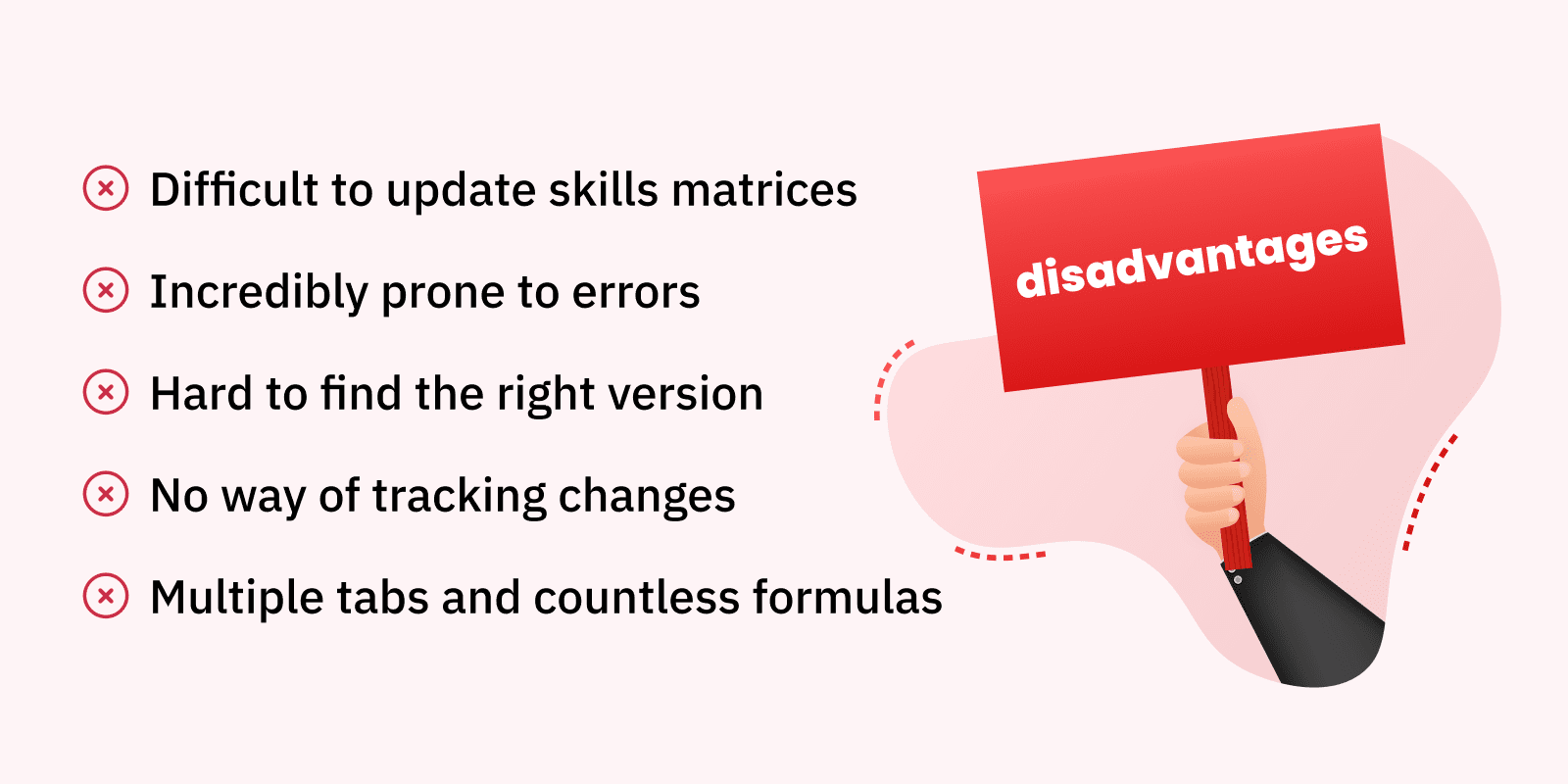
Five practical tips for creating skills matrices in spreadsheetsCopied
Here are a few things to consider when creating a spreadsheet skills matrix:
- Individual skills discrepancies are to be expected! Not everyone can take on the same number of tasks, master the same number of skills, or hold the same amount of certifications.
- Keep your skills matrices as simple as possible, limiting them solely to the principal skills, competences, tasks, qualifications, and certification relevant to each role.
- Creating, populating, and maintaining skills matrices requires preparation and discipline. This means you need to ensure that all your employees are on board with your new skills management strategy.
- Try to create separate matrices for hard skills and soft skills. This helps keep things better organized. You can easily lose sight of the bigger picture pile everything into a single skills matrix.
- Keep in mind sector- or industry-specific factors (qualifications, certification, etc.) that may affect your skills management policy and your skills matrices.
Want more free skills matrix templates? Check out our blog post that offers five free skills matrix templates!
Challenges when implementing a skills matrixCopied
Creating a skills matrix is one thing. Putting it to use is another – and brings with it a new roster of challenges. Here are three common challenges you may face when implementing a skills matrix in your organization.
-
- Gathering data. Collecting employee skills data involves time-consuming methods like surveys or interviews, especially challenging in larger organizations. It demands meticulous planning and execution to ensure comprehensive and accurate information.
- Managing data securely. Safeguarding employee skills data is crucial, requiring meticulous data privacy and security measures.
- Ensuring organization-wide buy-in. Employees and managers need to understand the purpose of skills matrices and how they will be used.
Still interested? Chapter 7 of our “Ultimate Guide to Creating an Excel Skills Matrix” takes a closer look at the challenges our customers often face when implementing a skills matrix in their organization.
What are the advantages of a skills matrix?Copied
Why are skills matrices so useful? Let’s take a look at how they help organizations master skills management. Here we are using the AG5 skills management software as an example.
1. Identifying critical roles and tasks
Because they clearly and concisely show the skills and certification your employees possess – as well as those they need – skills matrices allow you quickly and easily to identify critical roles and tasks
Skills matrices also serve as a great springboard for your company’s training and recruitment initiatives. A complete skills matrix pinpoints skills-related areas on which your organization needs to focus. These insights enable you to easily decide the best way to improve upon these areas, either by training existing employees or recruiting news ones to fill the “skills gap.”
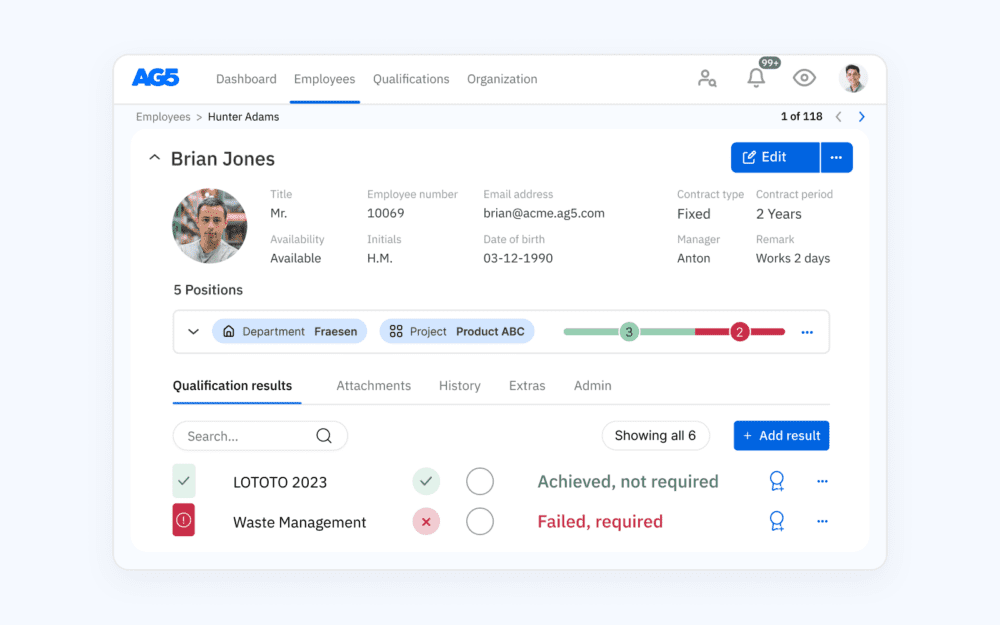
2. Finding replacements and responding to peaks in demand
Every organization has to deal with employees who are absent or off sick, as well as off period of peak demand. In such occasions, it’s important that you respond in such as way that safeguards productivity and continuity. This is much easier with an up-to-date overview of the skills, certifications, and qualifications your employees possess, as well as those that are necessary to perform certain roles or tasks.
3. Monitoring progress
A well-maintained skills matrix provides a clear picture of both individual and team progress, with professional development, productivity, and skill set growth are all clearly visible.
This means skills matrices are extremely useful for monitoring the effectiveness of your training programs – as well as pinpointing residual shortfalls and minimum requirements that may or may not be met.
4. Versatility and agility
You can use a skills matrix for specific purposes on teams, departments, and sites alike. They also offer the flexibility to create custom solutions, because you’re free to implement your skills matrices as you see fit.
5. Tracking key players
Skills matrices are clearly laid out, making it possible to pinpoint the employees who are key to keeping operations running, be it through important certifications or sought-after specializations. These employees are valuable to the organization as a whole, so it’s beneficial to be aware of exactly who they are – and what they can do.
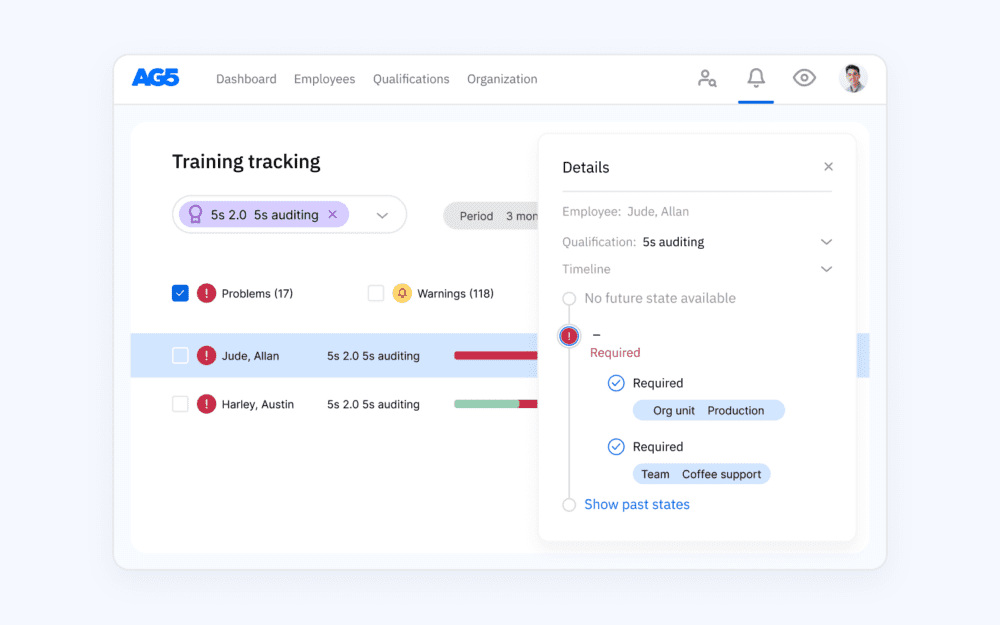
Take your skills matrix to the next level with AG5’s skills matrix softwareCopied
Have you tried managed skills matrices in Excel? Want an easier solution? Skills management software may be just what you’re looking for. Skills management software automates many of the tasks that you must manually accomplish with Excel.
Additionally, AG5’s software always provides an up-to-date overview of your employees’ skills, qualifications, and certifications.
With AG5, you can:
- Enter updates and training results from the shop floor, quickly and easily. This means AG5’s skills matrices are always up to date.
- Link specific team members to the expertise and experience required for specific jobs. This means you can create a “dream team” for every project.
- Set alerts for individual employees (or groups of employees) that hold specific certifications. With the click of a button, a list appears of every certification or qualification that’s about to expire. Both the employee in question and the HR department will automatically receive an alert in time to take appropriate action (i.e. renew a certification).
- Quickly find suitable replacements for employees out sick or otherwise absent.
- Use a drag-and-drop menu to replicate any organizational structure and create all the links you need between employees and qualifications, skills, or certifications. This enables you to create a skills matrix in just a few clicks.
- And much more!
When you’re ready to witness AG5 in action, get in touch to schedule a free, live, 15-minute demo that’s tailored to your organization.
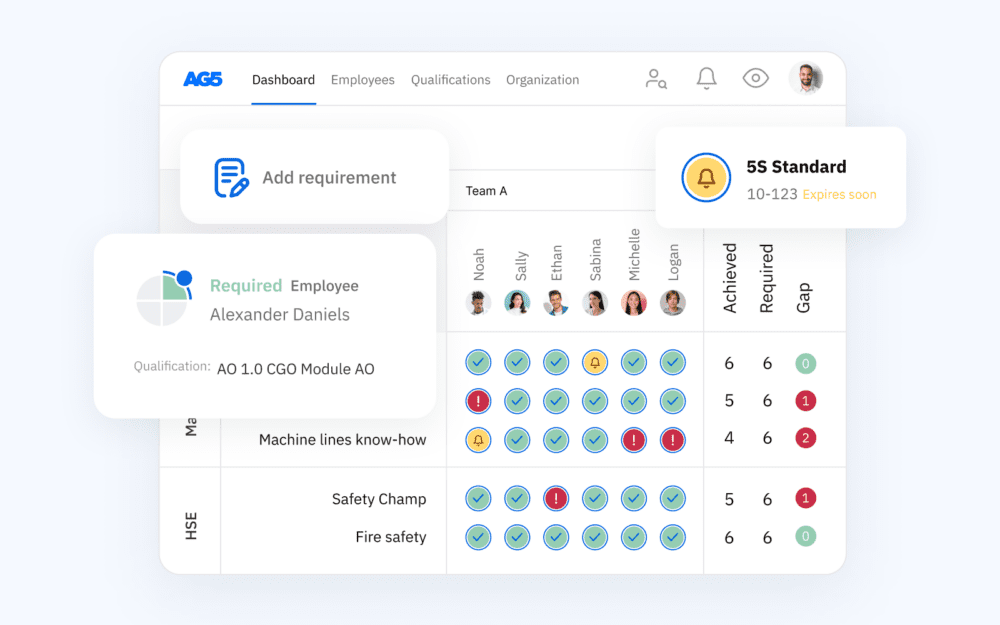
Simplify skills management with a chat
Curious about AG5? Let’s talk. Book a commitment-free intro call. Whether you’re considering or just curious about what AG5 has to offer. If we click, we’ll plan a detailed demo, tailored for you.
Why book an intro call?
- Understand your challenges: Your situation is unique. We get it.
- Explore possibilities: See how AG5 fits your goals.
- Next steps: Ready to dive deeper? Let’s schedule a demo.
Ready to explore a smarter way to manage skills? Click below to select a convenient time for you.
